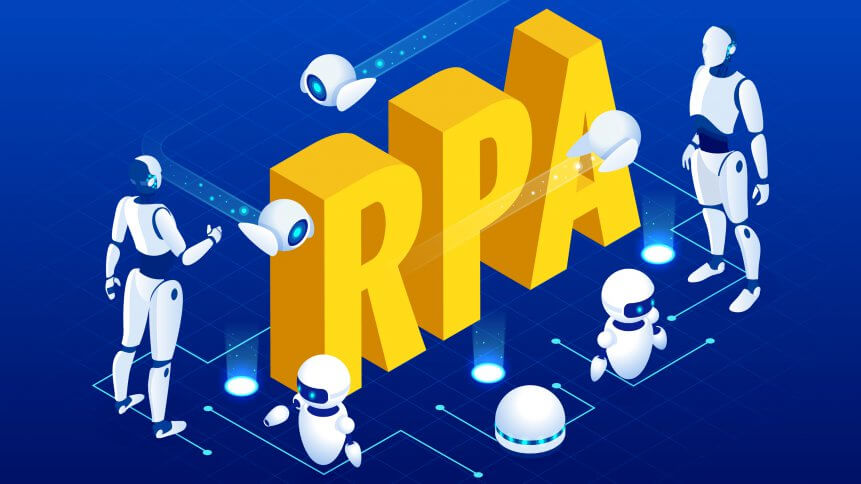RPA – the short and long-term solution to business continuity?

- Automation has for a long time been a cross-industry digital transformation goal, but now adoption’s being expedited
- RPA software is offering a solution for business continuity and IT adaptability
- The surge in interest is leading to new use cases and more advanced offerings from vendors
Before being blindsided by the pandemic, backend automation was at least on the radar of most firms in industries, from banking to healthcare. But interest has accelerated. Automation technology, more specifically Robotic Process Automation (RPA) software, has seen a spike in interest as businesses seek solutions to keep day-to-day operations running.
Faced with staff in lockdown, sudden spurts in service loads, changes in supply and demand patterns, businesses have scrambled for solutions that can ultimately drive efficiencies and reduce manpower, both now and in the longer term as an economic recession looms.
While enterprise tech spend has on the whole been stymied by financial and marketplace uncertainty, and subsequently shored-up budgets, RPA companies like Another Monday, PegaSystems and UiPath have reported increased business from existing and new customers.
“The global pandemic has shaken businesses across every industry, driving rapid changes to virtually the entire workforce and upending tech priorities for many CIOs this year,” Vijay Pullur, a digital transformation expert and CEO of corporate incubator Pramati, told TechHQ. “Digital transformation and workforce productivity has always been on the agenda for many businesses, but the path there was expected to take a minimum of three to five years.”
Now, the pressure to deliver these initiatives has increased many-fold as businesses are caught in a “do-or-die situation,” Pullur said
With call centers closed or running at half-capacity, deliveries delayed and services closed, self-service and customer care areas are key areas of RPA implementation, while banks are working with robotic software providers to process the surge of Paycheck Protection Program [PPP] loans for small businesses under the CARES Act, saving time that many small businesses don’t currently have when trying to retain their employees.
Hospitals and urgent-care centers are using the technology, which can work with existing legacy infrastructure, to handle administrative tasks related to scheduling and testing, freeing up hours of admin work so nurses and other medical professionals can spend more time tending to their patients and deliver treatment faster.
In the legal tech field, RPA and artificial intelligence are being used to automate the creation of legal documents for review and approval by legal experts, and in the medical insurance industry, if a customer files a claim, an app can process this as a job, auto-fill the claim using the information from the customer, and submit that data.
Across all these applications, as just a handful of examples, RPA “reduces error rates, processing costs and increases processing speed tenfold, while freeing up time spent on repetitive processes and automatically transcribing information from various sources across multiple systems.”
Halfway through 2020, Pullur continued, we are realizing that the impact of COVID-19 is not short-lived. Returning to business as usual will not be a case of getting staff back into offices or warehouses. Just like how e-commerce transformed retail for good, the pandemic has changed consumer and workforce behavior – there’s no going back to normal.
Within the last three months, ensuring business continuity has meant business leaders have had to connect a workforce that is distributed, working-remotely or deskless. They’ve had to onboard new employees, while keeping existing staff motivated, while enabling mobile access and rapid collaboration.
RPA the ‘integration glue’
The demanding circumstances of the last several months have put the pressure on CIOs to ensure their business IT infrastructure is fluid enough to implement new business processes, able to to modify existing ones and adapt to new workflows and applications. RPA is helping them ensure that IT infrastructure is agile enough to handle those challenges.
Aside from automating what would otherwise be manual tasks and functions, RPA is now also being used as an “integration glue”, connecting partner systems and other disparate systems to deliver new applications in high demand, Pullur told us.
While RPA is predominantly used to automate business processes, Pullur continued there are more cases of using RPA as an integration layer to quickly connect different emerging systems, where typically applications would be integrated using APIs. Creating APIs from scratch requires skilled developer teams, with a deep knowledge of software for which support and documentation may be scarce, and of course, time.
“Many legacy systems and internal applications do not have APIs,” explained Pullur; “RPA provides a quick-fix way of connecting systems to create purpose-built bridges. This takes minutes to achieve and does not require any developer skills and can be changed easily as business process changes occur.”
YOU MIGHT LIKE

RPA is all the rage – but is it really worth its salt?
Emulating the interactions of a human user with the system’s UI, RPA solutions can interact with systems by sidestepping any need for complex integrations.
The expedited interest in RPA will see the industry continue to evolve, adding further intelligence to relatively simple software that moves information from point A to point B: “In the first generation of RPA the automation was just about eliminating common manual functions. The next generation RPA is all about deploying AI assisted RPA that can adapt and learn as they go,” said Pullur.
Intelligent RPA software companies are emerging as differentiated offerings to existing RPA leaders, offering advanced solutions in applications such as smart scanning, image recognition, intelligent document processing and pattern recognition. Anticipate the demand for this kind of advanced RPA software, computing giant IBM yesterday (July 8) announced the acquisition of WDG Automation, to help “clients accelerate automation to more parts of the organization, not just to routine, but more complex tasks […]”
Singapore-based Glee Trees, for example, uses natural language processing (NLP) and contextual analysis to read both structured and unstructured data across a range of languages.









